
Canopic jars used by the ancient Egyptians during the mummification process to store and preserve the viscera of their owner for the afterlife. They were commonly either carved from limestone or were made of pottery. These jars were used by the ancient Egyptians from the time of the Old Kingdom until the time of the Late Period or the Ptolemaic Period, by which time the viscera were simply wrapped and placed with the body. The viscera were not kept in a single canopic jar: each jar was reserved for specific organs. The name "canopic" reflects the mistaken association by early Egyptologists with the Greek legend of Canopus.
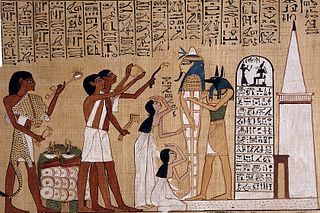
The ancient Egyptians had an elaborate set of funerary practices that they believed were necessary to ensure their immortality after death. These rituals and protocols included mummifying the body, casting magic spells, and burial with specific grave goods thought to be needed in the Egyptian afterlife.

Cats in ancient Egypt were represented in social and religious practices of Ancient Egypt for more than 30 centuries. Several Ancient Egyptian deities were depicted and sculptured with cat-like heads such as Mafdet, Bastet and Sekhmet, representing justice, fertility and power. The deity Mut was also depicted as a cat and in the company of a cat.
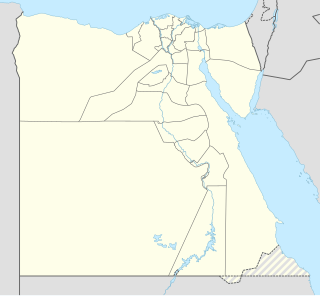
The Giza pyramid complex, also called the Giza Necropolis, is the site on the Giza Plateau in Egypt that includes the Great Pyramid of Giza, the Pyramid of Khafre, and the Pyramid of Menkaure, along with their associated pyramid complexes and the Great Sphinx of Giza. All were built during the Fourth Dynasty of the Old Kingdom of Ancient Egypt. The site also includes several cemeteries and the remains of a workers' village.

Beni Hasan is an Ancient Egyptian cemetery site. It is located approximately 20 kilometers (12 mi) to the south of modern-day Minya in the region known as Middle Egypt, the area between Asyut and Memphis.

Umm El Qaʻāb is a necropolis of the Early Dynastic Period kings at Abydos, Egypt. Its modern name means "Mother of Pots" as the whole area is littered with the broken pot shards of offerings made in earlier times. The cultic ancient name of the area was (w-)pkr or (rꜣ-)pkr "District of the pkr[-tree]" or "Opening of the pkr[-tree]", belonging to tꜣ-dsr "the secluded/cleared land" (necropolis) or crk-hh "Binding of Eternity".
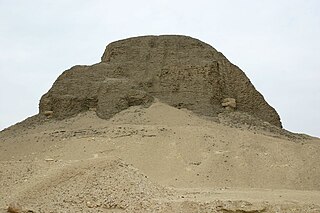
El Lahun is a village in Faiyum, Egypt. El Lahun is associated with the Pyramid of Senusret II, which is located near the modern town, and is often called the Pyramid of Lahun. The ancient name of the site was rꜣ-ḥn.t, literally, "Mouth of the Canal").

Nubkheperre Intef was an Egyptian king of the Seventeenth dynasty of Egypt at Thebes during the Second Intermediate Period, when Egypt was divided by rival dynasties including the Hyksos in Lower Egypt. He is known to be the brother of Sekhemre-Wepmaat Intef—and this king's immediate successor—since he donated Louvre Coffin E3019 for this king's burial which bears an inscription that it was donated for king Sekhemre Wepmaat Intef "as that which his brother, king Antefgives", notes Kim Ryholt. As the German scholar Thomas Schneider writes in the 2006 book Ancient Egyptian Chronology :
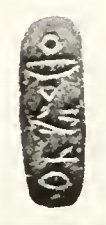
Nebmaatre is the prenomen of a poorly attested ruler of the late Second Intermediate Period of Ancient Egypt. Nebmaatre may have been a member of the early 17th dynasty and as such would have reigned over the Theban region. Alternatively, Jürgen von Beckerath believes that Nebmaatre was a ruler of the late 16th Dynasty.

Tarkhan is an Ancient Egyptian necropolis, located around 50 km south of Cairo on the west bank of the Nile.

Riqqeh is a modern village in Egypt. It is located about 80 km south of Cairo.

Seked is an ancient Egyptian term describing the inclination of the triangular faces of a right pyramid. The system was based on the Egyptian's length measure known as the royal cubit. It was subdivided into seven palms, each of which was sub-divided into four digits. The inclination of measured slopes was therefore expressed as the number of horizontal palms and digits relative to each royal cubit rise.

Menwadjre Sihathor was an ephemeral ruler of the 13th dynasty during the late Middle Kingdom. Sihathor may never have enjoyed an independent reign, possibly only ruling for a few months as a coregent with his brother Neferhotep I. According to egyptologist Kim Ryholt, Sihathor died in 1733 BC while Detlef Franke dates his short reign to 1694 BC. His tomb is likely to be the unfinished one located between the tombs of his brothers S9 and S10, in Abydos.

Hilda Mary Isabel Petrie was an Irish-born Egyptologist and wife of Flinders Petrie, the father of scientific archaeology. Having studied geology, she was hired by Flinders Petrie at age 25 as an artist, which led to their marriage and a working partnership that endured for their lifetimes. Hilda travelled and worked with Flinders Petrie to excavate and record numerous sites in Egypt, and later in Palestine. This included directing some excavations herself, and working in often difficult and dangerous conditions to produce copies of tomb hieroglyphs and plans, and to record the work for reports to the Egypt Exploration Fund. When the British School of Archaeology in Egypt was founded in 1905 in London by Flinders Petrie, she worked as its secretary and fundraiser to secure support for the school and their continued excavations. Hilda took part in archaeological excavations and surveys throughout her married life, except for a period while their two children were young. Her work was published, and she also gave public lectures in London and elsewhere.

S 10 is the modern name given to a monumental ancient Egyptian tomb complex at Abydos in Egypt. The tomb is most likely royal and dates to the mid-13th Dynasty. Finds from nearby tombs indicate that S10 suffered extensive state-sanctioned stone and grave robbing during the Second Intermediate Period, only a few decades after its construction, as well as during the later Roman and Coptic periods. These finds also show that S10 was used for an actual burial and belonged to a king "Sobekhotep", now believed to be pharaoh Sobekhotep IV. According to the Egyptologist Josef W. Wegner who excavated S10, the tomb might originally have been capped by a pyramid, although Aidan Dodson states that it is still unclear whether S10 was a pyramid or a mastaba.

Sedment is the name of a village in Egypt. In Egyptology it is mainly known for a series of cemeteries excavated near this village. The cemeteries were the target of several expeditions, the most substantial one under Flinders Petrie and Guy Brunton. Their work was published in two volumes. They found several hundred burials dating from around 3000 BC to the New Kingdom. Especially many burials were found dating to the First Intermediate Period and New Kingdom. The First Intermediate Period burials contained several inscribed coffins, but also many burials with wooden models. The New Kingdom burials were found much looted, but some reliefs found demonstrate that several tombs were adorned with a relief–decorated chapel above ground. The largest tomb was that of the vizier Prehotep who was in office under king Ramses II.

The Tomb of Anedjib is in Abydos, Egypt, in the Umm el-Qa'ab necropolis. Anedjib was a ruler of the First Dynasty of Egypt, who reigned around 2900 BC.

Hypselis or Hypsela, known to the ancient Egyptians as Shashotep, is an ancient Egyptian city and Roman bishopric, which was located near the modern town of Shutb in the Asyut Governorate.
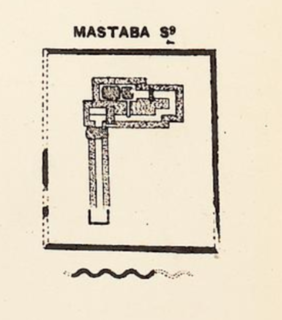
S 9 is the modern name given to a monumental ancient Egyptian tomb complex at Abydos in Egypt. The tomb is most likely royal and dates to the mid-13th Dynasty, during the late Middle Kingdom. Finds from the area of the tomb indicate that S9 suffered extensive, state-sanctioned stone and grave robbing during the Second Intermediate Period, only a few decades after its construction, as well as during the later Roman and Coptic periods. Although no direct evidence was found to determine the tomb owner, strong indirect evidence suggest that the neighbouring and slightly smaller tomb S10 belongs to pharaoh Sobekhotep IV. Consequently, S9 has been tentatively attributed by the Egyptologist Josef W. Wegner to Sobekhotep IV's predecessor and brother, Neferhotep I . According to Wegner, the tomb might originally have been capped by a pyramid.





















